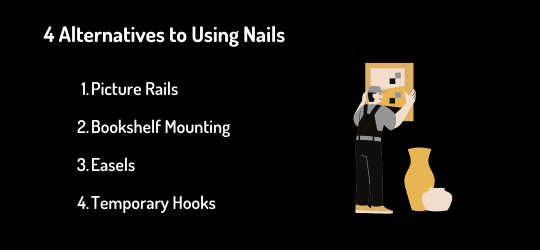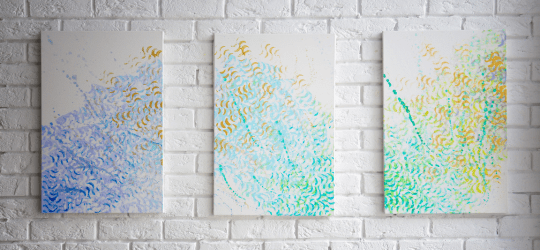Hanging pictures and art on the wall can make a space feel more personalised, cosy, and homely. However, hanging pictures can be a daunting and damaging process – especially when using nails to hang the pictures or art.
When you use nails to hang pictures, it becomes a job you only want to do once and do well. Because if you get it wrong, you’ll be left with a bunch of holes in the wall that not only look bad, but can also cause damage. Using nails also means you won’t have the flexibility to move your pictures around as you change your mind on design, layout, or furniture.
Hanging pictures without nails is possible. There are alternative picture-hanging options to get around the issues that nails can cause and provide flexibility to move your pictures around as you please.

Pros and cons of using nails
Pros of using nails for hanging pictures
- Cost-effective: Hanging pictures with nails is generally a cheap solution when hanging smaller to medium pieces because it doesn’t require many tools or nails. A single nail is sufficient for lighter hanging, but two can be used to ensure more stability.
- Bend with movement: Nails are ductile and can bend, and are therefore more forgiving with movement. This is beneficial when the wood in the walls expands or contracts from weather changes.
Cons of using nails for hanging pictures
- Leaves small holes: Hanging pictures with nails leaves holes in the walls and can cause serious long-term damage to the wall. This often leads to maintenance issues and requires frequent repairs. Also not ideal if you’re renting.
- Room for error: If nails are improperly installed, they can become loose from the wall and fall unexpectedly – damaging the picture or art and becoming a safety issue.
- Not suitable for heavy hangings: Nails are not suitable for heavy hangings and when they are used for a heavy picture frame, the nail will eventually fall out of the wall and damage the drywall. A single nail often holds 20 pounds (9 kg) in weight.
Reasons to look for alternate hanging methods
The holes that result from hanging pictures with nails can cause quite the eyesore when removed. Because of this, hanging pictures with nails isn’t an option. Plenty of landlords are also not keen on tenants putting holes in the walls, including hanging pictures with nails. In this case, tenants must look for alternate hanging methods when hanging art in a rental to personalise the space.
Alternate hanging methods also provide more flexibility when moving pictures around. Without the worry of leaving a hole behind from a nail, you can change the design of your space or add furniture, like a bookshelf or cabinet, more seamlessly.

4 alternatives to using nails
Picture Rails
From a home or office to an art gallery – picture rails are becoming the new standard for displaying art. Picture rails are a secure picture-hanging system that suspends frames from a rail installed along the top of a wall instead of being hung on nails that can damage the wall. Attached to the picture rail are invisible wires on which the artwork is hung – creating a floating visual.
The security and strength of picture rails provide increased protection for artwork. The picture rails also mean picture hangings can be easily adjusted by sliding the wires along the length of the rails. Hangings can be hung side by side or above one another – allowing for flexibility and change of mind.
Bookshelf Mounting
Bookshelves house a range of decorative objects like art pieces, vinyl collections, and books (of course!), but they can also be used to mount picture hangings. Mounting picture hangings between shelves on a bookshelf is a creative approach to avoiding using nails to hang pictures on the walls.
Easels
Easels are used to hold an artist’s canvas while painting, but they can also be used to hold pictures as an alternative to hanging them on the wall with nails. If you have the space, easels add an extra layer to a room and become a focal point – perfect for putting special pictures or art on.
Temporary Hooks
Temporary hooks are sticky strips which contain a pressure-sensitive adhesive that sticks to the wall reliably, while allowing them to be easily removed without residue left behind on the wall. Temporary hooks provide a hook to hang the pictures on without damaging the wall with nail holes.
